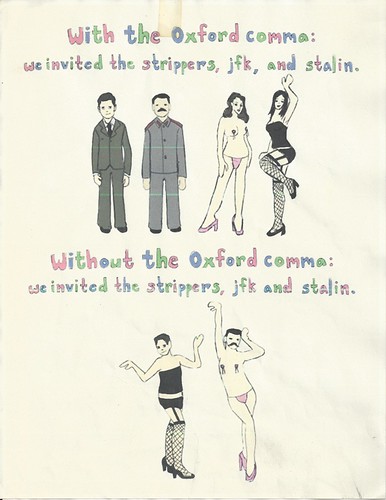
PREV ARTICLE
NEXT ARTICLE
FULL ISSUE
STILL MORE ON THE SERIAL COMMASerge Pelletier writes:
As a member of the Editors' Association of Canada for many years, I can tell you that 95% of its members favour the serial comma.
As a translator, I can tell you that I highly favour the serial comma because it takes away any ambiguity there might be. Fred Schwan writes:
I do not have any comments on the serial comma, but I do have a comment on this comment on the serial comma:
Regarding the "Oxford comma", since we're talking about the Oxford Numismatic Society's list - rules are good but sometimes they need to be handled flexibly when the sense demands it, or when sticking too firmly to them might result in ambiguity. The examples you quote cover the ground nicely... One of my personal grammar issues is the placement of minor punctuation (meaning periods and commas) and quotation marks. In American use the minor punctuation always goes inside the quotation marks. British use, in order for the punctuation to be inside the quotation marks, the punctuation has to be part of the quote. This is a logical approach but it creates the unsightly ""Oxford comma"," situation. By the way, I am entirely uncertain about the use of quotation marks in that last sentence. Anyway, to me the humor to me was the incorrect American use not only in a discussion of punctuation use, but also in a phrase with the word Oxford! Thanks for your great service and Happy New Year to you and the entire E-Sylum staff!
I've been remiss in not thanking the E-Sylum staff myself. Kudos to webmaster Bruce Perdue for his regular-as-clockwork service to install each issue in our web site archive and keep the NBS home page up to date. Thanks are also due John Nebel for his continued free hosting of the NBS web site on his servers. And of course, we couldn't do this at all without the great input of you, our readers. Your contributions are what drive each issue and make it great. Keep those e-mails coming!
-Editor
When an elementary school teacher begins to teach her students about grammar and punctuation, one of the very first things taught is that a comma represents a pause in speech.
Anyone who was listening back then knows that use of the last serial comma is correct, because there is the same pause after B as there is after A. (in the example of A, B, and C) This obviates the need for books, complicated rules and PhD's. (I don't mean to insult any complicated PhD's.) Paul Cunningham writes:
Whenever I see The E-Sylum on my computer I look forward to something between superfragilisticexpialidosious and inanity! This time it is the continuing battle amongst the commaists.
I see another grammatical example in this issue – Is it “1930s” or “1930’s? “ Even the grammarians may be reaching for their manuals to check that sentence!
Both forms are quite common. I generally use "1930s". I haven't checked any manuals, though...
-Editor
To read the earlier E-Sylum article, see:
MORE ON USING THE SERIAL COMMA
(www.coinbooks.org/esylum_v16n53a13.html)
The Numismatic Bibliomania Society is a non-profit organization promoting numismatic literature. See our web site at coinbooks.org. To submit items for publication in The E-Sylum, write to the Editor at this address: whomren@gmail.com To subscribe go to: https://my.binhost.com/lists/listinfo/esylum All Rights Reserved. NBS Home Page Contact the NBS webmaster 
|
